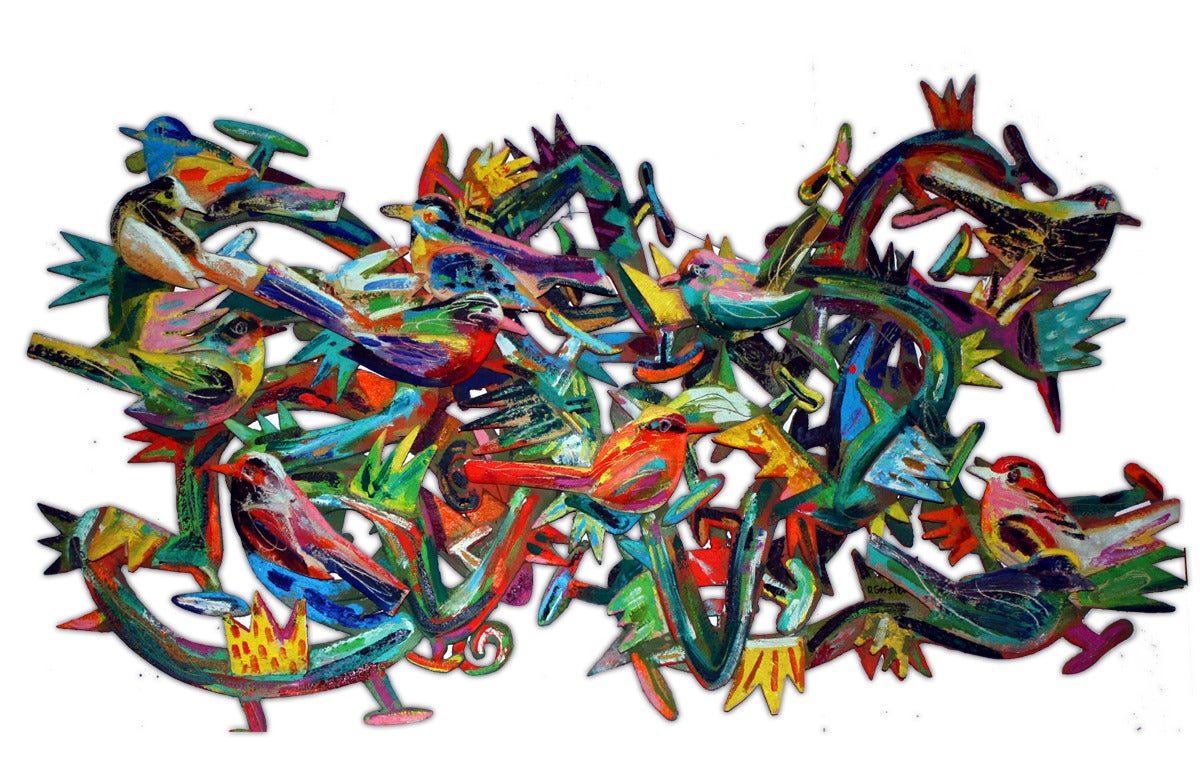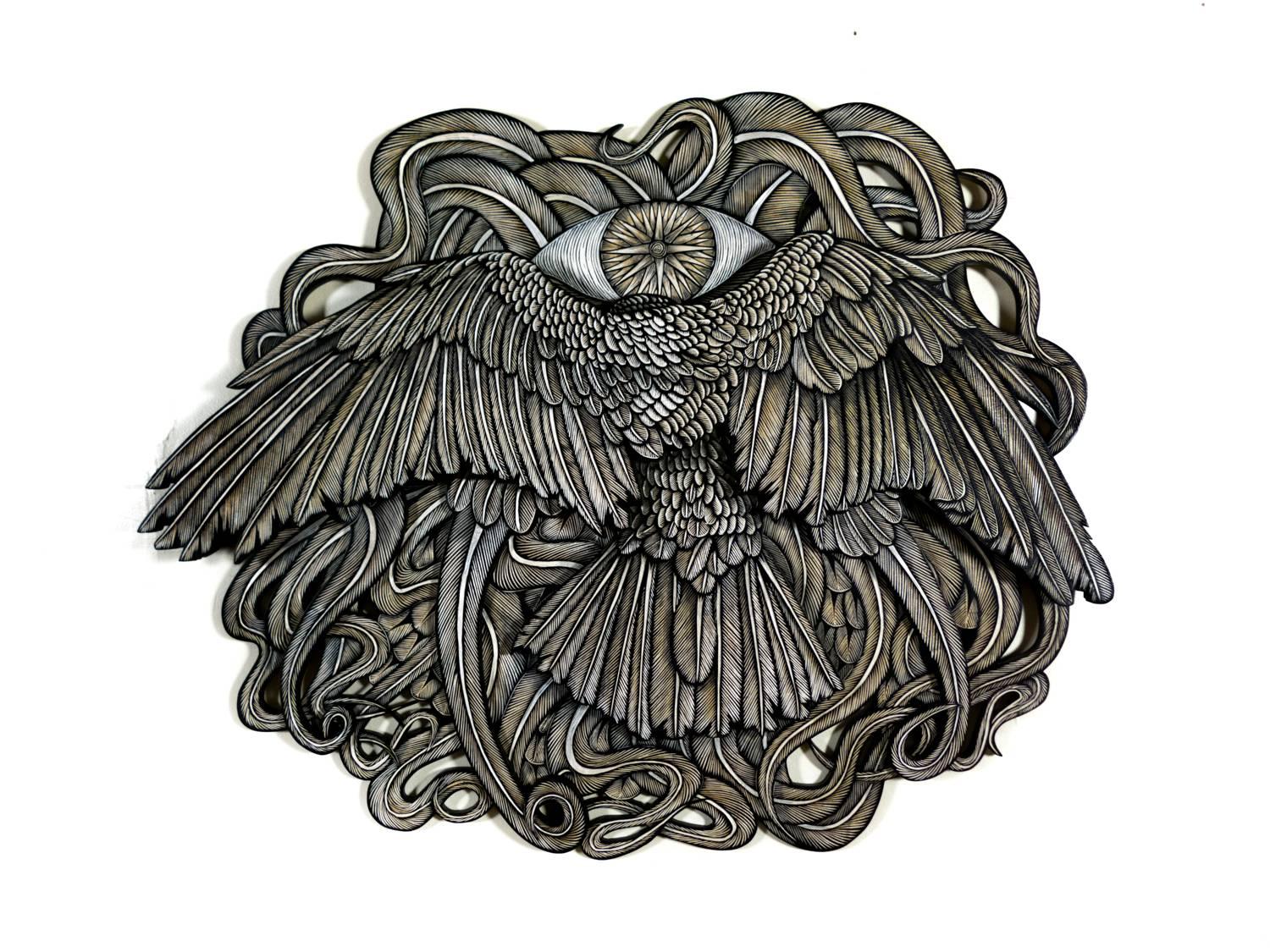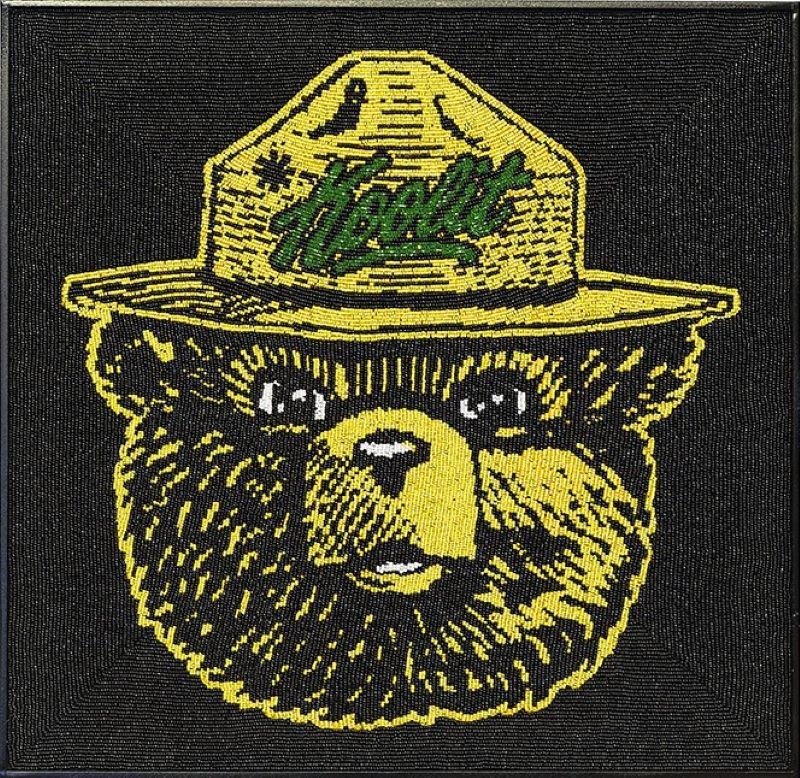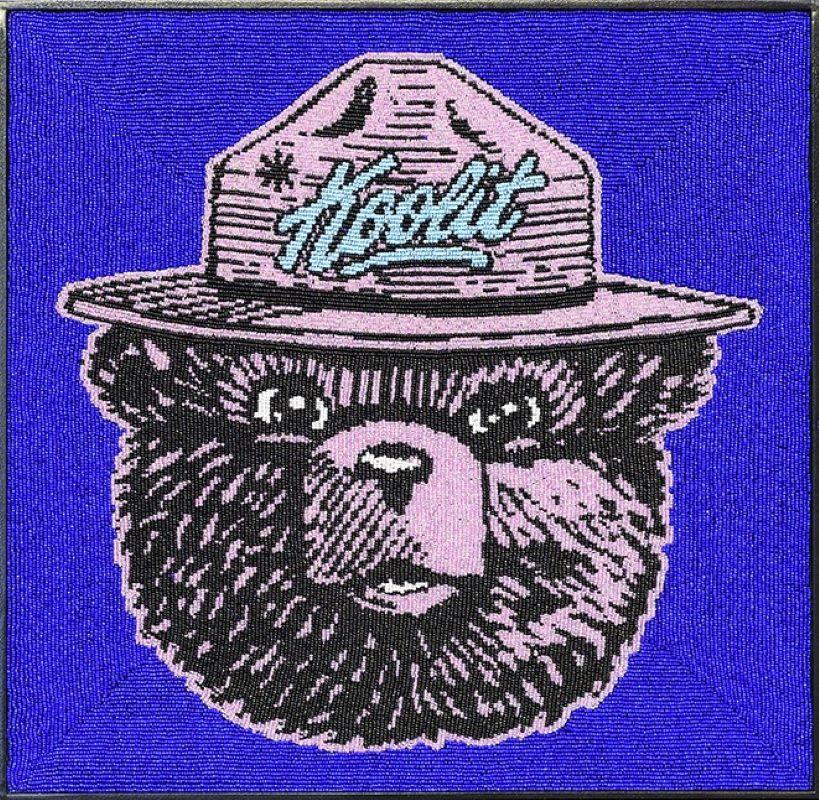Items Similar to French Folk Art Hand Carved Painted Whimsical Childrens Cat Chair Gerard Rigot
Want more images or videos?
Request additional images or videos from the seller
1 of 13
Gerard RigotFrench Folk Art Hand Carved Painted Whimsical Childrens Cat Chair Gerard Rigotc.1980's
c.1980's
About the Item
Gerard Rigot (France, 1929-)
Animeubles, Child's Chair
Circa, 1980's
Folk art, hand carved chair in the form of a cat.
Hand signed on bottom
Endorsed by the Musee des Arts Decoratifs, Paris.
Dimensions: Measures 23" x 19" x 13"
The chair is made from softwood, probably pine, alder, ash, birch or hornbeam. It stands on four legs and has a simple D-shaped form. A carved cat’s head adorns the proper right arm, and an erect tail the proper left. The legs of the chair are shaped at the feet to resemble a cat’s paws. The whole chair is painted in simple, dilute oil colours, predominantly a soft red, with a green gray seat and blue-white stripes on the tail and body. The facial features are highlighted. The artist’s signature is painted in black on the underside of the seat.
Gerard Rigot was born in the suburbs of Paris in 1929, and began sculpting and painting whimsical fantastic wood furniture after moving to the countryside at the age of 49.
Before becoming a full-time artist in the late-1970s, Rigot had a varied career including stints as a soldier and a photography assistant, his practice being particularly influenced by a period he spent working as a teacher in Algeria. When the painter Gerard Rigot bought a farmhouse in Toulouse, France, he began to make furniture. Inspired by his cat and using native oak and pine, he carved and painted playfull naive animal furniture: cat chairs and toucan benches. In Monsieur Rigot’s small atelier an assistant cuts the wood into rough shapes. Mr. Rigot uses hand tools to refine the shapes, and he joins them with dowels. When he paints the pieces he takes liberties with the animals’ colors, using bright hues – a camel might be yellow – but he captures the particular charm and posture of each animal.
The furniture thus combines fantasy and function, but it is also comfortable. One chair has a cat on each side, the arched backs serving as armrests. A chest is in the guise of a hippopotamus wallowing in water, the wavy stripes painted beneath the animal’s body suggesting rippling water. The back of another chair is formed by two kissing giraffes, their necks gracefully arching toward each other. While most of his furniture depicts animals, Rigot also uses people as inspiration; a cupboard is in the shape of a voluptuous woman. His work is of the same vein as Henri Maik, Gustavo Novoa, Camille Bombois and Annette Ollivary.
Gérard Rigot, adds a whole new dimension of whimsy to carved animal furniture. Chairs that used the curved arch of a cat’s back to create the shape of the arms, and dressing tables with long-necked pelicans holding each side of a fish flanked mirror in their beaks. While cats continue to feature heavily in his more recent designs, he does also branch out to flamingos, antelopes and bears in his furniture designs. A particular highlight is a crowing rooster whose tail lends itself perfectly to a table lamp, the feathers masking a lightbulb. His furniture does not exclusively feature animals, however. In one chair, two mermaids’ bodies form the arms and front legs of the chair, while their flowing hair connects to form the back.
Like the Indonesian furniture, Rigot’s creations tread the fine line between form and function, finding the parallels between animals and furniture, and then manipulating those similarities to create thoroughly unique objects that are as useful as they are playful.
Rigot had already been successful as a more commercial artist, working predominantly in bronze and making figurative sculptures. It was when he bought a farmhouse at the age of 49, and trading his urban hometown of Paris for the more rural Toulouse, that he began sculpting furniture. Initially, the sculptures were for his own home, but have, more recently, also found commercial success, fetching thousands of dollars at auction.
Gerard Rigot's house was featured in House and Garden UK in May 1988.
- Creator:Gerard Rigot (1929)
- Creation Year:c.1980's
- Dimensions:Height: 23 in (58.42 cm)Width: 19 in (48.26 cm)Depth: 13 in (33.02 cm)
- Medium:
- Movement & Style:
- Period:
- Condition:Please see photos. minor wear commensurate with age and technique.
- Gallery Location:Surfside, FL
- Reference Number:1stDibs: LU38214190712
About the Seller
4.9
Platinum Seller
These expertly vetted sellers are 1stDibs' most experienced sellers and are rated highest by our customers.
Established in 1995
1stDibs seller since 2014
1,548 sales on 1stDibs
Typical response time: 1 hour
- ShippingRetrieving quote...Ships From: Surfside, FL
- Return PolicyA return for this item may be initiated within 3 days of delivery.
More From This SellerView All
- Hand Carved Painted Wood Folk Art Americana Sculpture Pair American GothicBy Curtis JeréLocated in Surfside, FLC. Jeré ( or Curtis Jere) is a metalwork artist of wall sculptures and household accessories. C. Jeré works are made by Artisan House. Curtis Jere is a compound nom de plume of artis...Category
1980s Folk Art Figurative Sculptures
MaterialsMetal
- Whimsical French Folk Art, Naive, Oil Painting Madeline Marie Christine ClavierBy Madeline Christine ClavierLocated in Surfside, FLMADELINE CHRISTINE CLAVIER (1913-2015) Signature: Signed lower right & titled verso Medium: Oil on canvas Provenance: The collection of the artist's family Marie Christine Clavier was born in Saigon, Vietnam in 1913 to French parents and lived there for her formative years. She returned to France as a teenager and began to study painting. Her work quickly developed into whimsical paintings of poetry and songs – harmonized in a unique and distinct painting technique. Her work has an impasto feel and a folk art, outsider artist sensibility to it. Similar in style to Maik and other fantasy realists who use animals, flowers and foliage in their artworks. Marie Clavier painted ro herself rather than for profit as she was quite independently wealthy. She exhibited extensively in the United States in the 1970s especially across Connecticut and New York, showing at various galleries and cultural centres. She had numerous solo exhibitions in the 1970’s- notably at the Maison Francaise in New York and New York University. She showed at Galerie Bernheim Jeune in Paris. She won many awards for her work including Gold Medals and Palme D’Or medals. In 1988 the prestigious art publisher Leopard D’Or produced catalogue book on her life and work – by this point she had virtually given up painting. She died in 2015 aged 102. Bernheim-Jeune gallery is one of the oldest art galleries in Paris. Opened on Rue Laffitte in 1863 by Alexandre Bernheim (1839-1915), friend of Delacroix, Corot and Courbet, it changed location a few times before settling on Avenue Matignon. The gallery promoted realists, Barbizon school paintings and, in 1874, the first impressionist and later post-impressionist painters. It closed in 2019. In 1901, Alexandre Bernheim, with his sons, Josse (1870-1941), and Gaston (1870-1953), organized the first important exhibition of Vincent van Gogh paintings in Paris with the help of art critic Julien Leclercq. In 1906, Bernheim-Jeune frères started presenting works by Pierre Bonnard, Edouard Vuillard, Paul Cezanne, Henri-Edmond Cross, Kees van Dongen, Henri Matisse, Le Douanier Rousseau, Raoul Dufy, Maurice de Vlaminck, Amedeo Modigliani, Maurice Utrillo and Georges Dufrenoy...Category
20th Century Folk Art Animal Paintings
MaterialsCanvas, Oil
- Whimsical French Folk Art, Naive, Oil Painting Madeline Marie Christine ClavierBy Madeline Christine ClavierLocated in Surfside, FLMADELINE CHRISTINE CLAVIER (1913-2015) Signature: Signed lower right & titled verso Medium: Oil on canvas Provenance: The collection of the artist's family Marie Christine Clavier was born in Saigon, Vietnam in 1913 to French parents and lived there for her formative years. She returned to France as a teenager and began to study painting. Her work quickly developed into whimsical paintings of poetry and songs – harmonized in a unique and distinct painting technique. Her work has an impasto feel and a folk art, outsider artist sensibility to it. Similar in style to Maik and other fantasy realists who use animals, flowers and foliage in their artworks. Marie Clavier painted ro herself rather than for profit as she was quite independently wealthy. She exhibited extensively in the United States in the 1970s especially across Connecticut and New York, showing at various galleries and cultural centres. She had numerous solo exhibitions in the 1970’s- notably at the Maison Francaise in New York and New York University. She showed at Galerie Bernheim Jeune in Paris. She won many awards for her work including Gold Medals and Palme D’Or medals. In 1988 the prestigious art publisher Leopard D’Or produced catalogue book on her life and work – by this point she had virtually given up painting. She died in 2015 aged 102. Bernheim-Jeune gallery is one of the oldest art galleries in Paris. Opened on Rue Laffitte in 1863 by Alexandre Bernheim (1839-1915), friend of Delacroix, Corot and Courbet, it changed location a few times before settling on Avenue Matignon. The gallery promoted realists, Barbizon school paintings and, in 1874, the first impressionist and later post-impressionist painters. It closed in 2019. In 1901, Alexandre Bernheim, with his sons, Josse (1870-1941), and Gaston (1870-1953), organized the first important exhibition of Vincent van Gogh paintings in Paris with the help of art critic Julien Leclercq. In 1906, Bernheim-Jeune frères started presenting works by Pierre Bonnard, Edouard Vuillard, Paul Cezanne, Henri-Edmond Cross, Kees van Dongen, Henri Matisse, Le Douanier Rousseau, Raoul Dufy, Maurice de Vlaminck, Amedeo Modigliani, Maurice Utrillo and Georges Dufrenoy. From 1906 to 1925, art critic Félix Fénéon was the director of the gallery and was instrumental in bringing in the art of Georges Seurat and Umberto Boccioni. In 1922, an exhibition brought together works by Alice Halicka, Auguste Herbin, Pierre Hodé...Category
20th Century Folk Art Animal Paintings
MaterialsCanvas, Oil
- Mexican Whimsical Folk Art Lion Painting AnimaliaBy Jose Maria de ServinLocated in Surfside, FLPainting on burlap by Jose Maria de Servin of an Abstract Naive Lion animal using bright colors and geometric patterns. In this piece the artist simplifies the representation of the ...Category
Mid-20th Century Folk Art Animal Paintings
MaterialsBurlap, Oil
- Israeli Judaica Shtetl Family Shabbat Scene Naive Art Oil PaintingBy Natan HeberLocated in Surfside, FLNatan Heber was trained by his father in Poland to be a ritual slaughterer. In 1925, he joined the Zionist movement "Mizrachi" and in 1936 immigrated to Palestine where he opened a poultry shop in Haifa. He began to paint at the age of sixty-one, after ill health forced him to retire. Driven by a need to memorialize his family and their shtetl community lost in the Holocaust, he drew scenes of traditional Jewish life. Unfamiliar with the conventions of scale and perspective, he set his heavily outlined frontal figures on steeply rising surfaces and often portrayed his father in monumental size to mark his importance. One of Israel's greatest naive-style painters. Along with Shalom of Safed, Kopel Gurwin and Gabriel Cohen, He is renowned as one of Israel's greatest living naive-style folk art painters, The Haifa Museum of Art will be opening the first ever Outsider Art exhibition (also known as Art Brut) in Israel in January 2013. He was included in the show of Outsider art at Haifa Museum The exhibition included works by Classical Outsider artists, none of them have ever been shown in Israel - Henry Darger, Martin Ramirez, Adolf Wölfli, Aloïse, Hauser, Carlo Zinnelli, Bill Traylor, Minnie Evans...Category
Mid-20th Century Folk Art Animal Paintings
MaterialsBoard, Oil
- Whimsical French Folk Art, Naive, Oil Painting Madeline Marie Christine ClavierBy Madeline Christine ClavierLocated in Surfside, FLMADELINE CHRISTINE CLAVIER (1913-2015) Signature: Signed lower right & titled verso Medium: Oil on canvas Provenance: The collection of the artist's family Marie Christine Clavier was born in Saigon, Vietnam in 1913 to French parents and lived there for her formative years. She returned to France as a teenager and began to study painting. Her work quickly developed into whimsical paintings of poetry and songs – harmonized in a unique and distinct painting technique. Her work has an impasto feel and a folk art, outsider artist sensibility to it. Similar in style to Maik and other fantasy realists who use animals, flowers and foliage in their artworks. Marie Clavier painted ro herself rather than for profit as she was quite independently wealthy. Her work is in a more whimsical style of Francoise Gilot. She exhibited extensively in the United States in the 1970s especially across Connecticut and New York, showing at various galleries and cultural centres. She had numerous solo exhibitions in the 1970’s- notably at the Maison Francaise in New York and New York University. She showed at Galerie Bernheim Jeune in Paris. She won many awards for her work including Gold Medals and Palme D’Or medals. In 1988 the prestigious art publisher Leopard D’Or produced catalogue book on her life and work – by this point she had virtually given up painting. She died in 2015 aged 102. Bernheim-Jeune gallery is one of the oldest art galleries in Paris. Opened on Rue Laffitte in 1863 by Alexandre Bernheim (1839-1915), friend of Delacroix, Corot and Courbet, it changed location a few times before settling on Avenue Matignon. The gallery promoted realists, Barbizon school paintings and, in 1874, the first impressionist and later post-impressionist painters. It closed in 2019. In 1901, Alexandre Bernheim, with his sons, Josse (1870-1941), and Gaston (1870-1953), organized the first important exhibition of Vincent van Gogh paintings in Paris with the help of art critic Julien Leclercq. In 1906, Bernheim-Jeune frères started presenting works by Pierre Bonnard, Edouard Vuillard, Paul Cezanne, Henri-Edmond Cross, Kees van Dongen, Henri Matisse, Le Douanier Rousseau, Raoul Dufy, Maurice de Vlaminck, Amedeo Modigliani, Maurice Utrillo and Georges Dufrenoy. From 1906 to 1925, art critic Félix Fénéon was the director of the gallery and was instrumental in bringing in the art of Georges Seurat and Umberto Boccioni. In 1922, an exhibition brought together works by Alice Halicka, Auguste Herbin, Pierre Hodé, Moise Kisling, Marie Laurencin, Henri Lebasque, Fernand Leger and Henri Matisse. The gallery now exhibits painters and sculptors in the tradition of the École de Paris and artists such as Jean Carzou, Shelomo Selinger or Pollès. Her style is a recognizable, cheerful, whimsical and a happy creation. Naïve art is any form of visual art that is created by a person who lacks the formal education and training that a professional artist undergoes (in anatomy, art history, technique, perspective, ways of seeing). Unlike folk art, naïve art does not necessarily evince a distinct cultural context or tradition. Naïve art is recognized, and often imitated, for its childlike simplicity and frankness. Paintings of this kind typically have a flat rendering style with a rudimentary expression of perspective. One particularly influential painter of "naïve art" was Henri Rousseau (1844–1910), a French Post-Impressionist who was discovered by Pablo Picasso. Naïve art is often seen as outsider art that is by someone without formal (or little) training or degree. While this was true before the twentieth century, there are now academies for naïve art. Naïve art is now a fully recognized art genre, represented in art galleries worldwide. Museums devoted to naïve art now exist in Kecskemét, Hungary; Riga, Latvia; Jaen, Spain; Rio de Janeiro, Brasil; Vicq France and Paris. Another term related to (but not completely synonymous with) naïve art is folk art. There also exist the terms "naïvism" and "primitivism" which are usually applied to professional painters working in the style of naïve art (like Paul Gauguin, Mikhail Larionov, Paul Klee). At all events, naive art can be regarded as having occupied an "official" position in the annals of twentieth-century art since - at the very latest - the publication of the Der Blaue Reiter, an almanac in 1912. Wassily Kandinsky and Franz Marc, who brought out the almanac, presented 6 reproductions of paintings by le Douanier' Rousseau (Henri Rousseau), comparing them with other pictorial examples. However, most experts agree that the year that naive art was "discovered" was 1885, when the painter Paul Signac became aware of the talents of Henri Rousseau and set about organizing exhibitions of his work in a number of prestigious galleries. The Earth Group (Grupa Zemlja) were Croatian artists, architects and intellectuals active in Zagreb from 1929 to 1935. The group included the painters Krsto Hegedušić, Edo Kovačević, Omer Mujadžić, Kamilo Ružička, Ivan Tabaković, and Oton Postružnik, the sculptors Antun Augustinčić, Frano Kršinić, and the architect Drago Ibler. A term applied to Yugoslav (Croatian) naive painters working in or around the village of Hlebine, near the Hungarian border, from about 1930. Some of the best known naive artists are Dragan Gaži, Ivan Generalić, Josip Generalić...Category
20th Century Folk Art Animal Paintings
MaterialsCanvas, Oil
You May Also Like
- BirdsBy David GersteinLocated in Buffalo, NYAn original one of a kind hand carved and painting wall sculpture by Israeli artist David Gerstein. David Gerstein is an Israeli painter and sculptor. He began as a figurative pai...Category
1990s Pop Art Animal Paintings
MaterialsOil, Wood
- White Raven IIBy Dennis McNettLocated in Philadelphia, PA"White Raven II" is an original hand-painted wall-hanging woodcarving by Dennis McNett (also known as Wolfbat) measuring 41”h x 50”w x 2”d. Please send us...Category
21st Century and Contemporary Contemporary Figurative Sculptures
MaterialsAcrylic, Wood
- Infernus #1Located in Denver, COElectric Coffin is coded within art history and ideologies from archetypes of mysticism. We explore found truths from modernity and a personal historical perspective. A process-drive...Category
2010s Contemporary Animal Paintings
MaterialsCanvas, Glass, Wood, Mixed Media, Acrylic
- Vapos #1Located in Denver, COElectric Coffin is coded within art history and ideologies from archetypes of mysticism. We explore found truths from modernity and a personal historical perspective. A process-drive...Category
2010s Contemporary Figurative Sculptures
MaterialsCanvas, Glass, Wood, Mixed Media, Acrylic
- ReciprocityLocated in Denver, COMarisa Aragón Ware's "Reciprocity" is an original, hand made paper sculpture that depicts a honey bee preparing to land and collect nectar from a wh...Category
21st Century and Contemporary Figurative Sculptures
MaterialsPaper, Watercolor
- InevitabilityBy AiromLocated in Santa Monica, CAFrom the Post Conception series.Category
21st Century and Contemporary Surrealist Animal Paintings
MaterialsOil, Polymer





